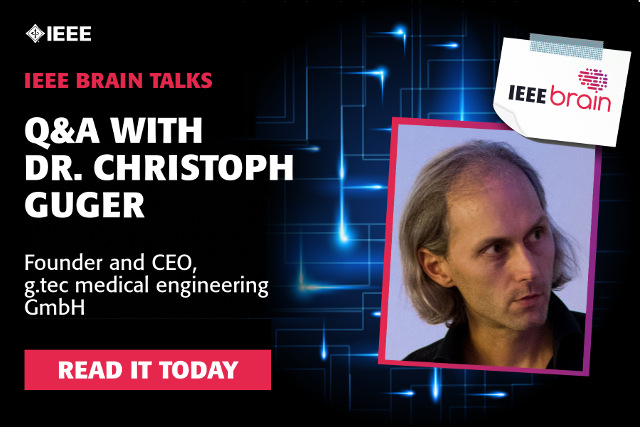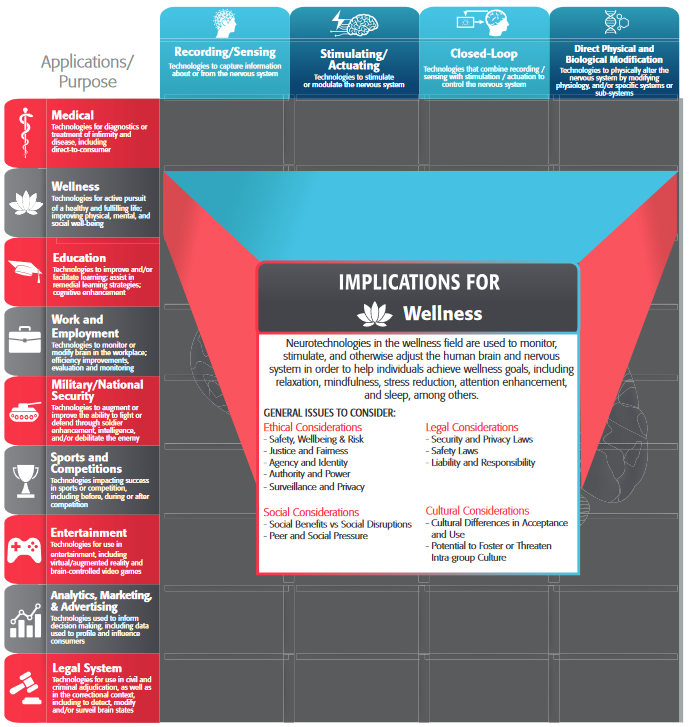Christoph Guger is co-founder of g.tec medical engineering in Austria, which has been developing high-performance brain-computer interfaces and neurotechnologies for invasive and non-invasive recordings since 1999. Dr. Guger oversees the global distribution and utilization of g.tec’s products in clinical environments for research purposes such as the analysis of the brain, heart or muscle activity, brain assessments of severe brain injuries and disorders of consciousness, motor rehabilitation after stroke, neuromarketing, deep brain stimulation, brain mapping, neuro prosthesis control, communication, painting and closed-loop invasive and non-invasive BCI experiments.
How did you first become interested in brain-computer interface research?
Christoph Guger: When I was studying in the U.S. at Johns Hopkins, I heard about a professor doing brain-computer interface research in my home country Austria. Upon my return, I was introduced to Prof. Gert Pfurtscheller, and then began to pursue both my Master and PhD thesis through his lab. As I was finishing my PhD at the university, I began to receive inquiries about selling the BCI system, which led to the launch of my company g.tec and the first sales of the system to Oxford and to South Korea. Initial sales were primarily for the research markets so that people could do their own applications and neuroscience experiments.
What are some of the practical applications of the g.tec BCI system?
Christoph Guger: The system has many different electrodes and bio-signal amplifiers and real-time processing components where everything is implemented for people wanting to do BCI applications. So, it’s a kind of rapid prototyping environment where you get all the pieces and then in just a few hours you can modify it and run your own experiment. For that reason, it’s very useful for research institutions, but also for industry to do neuroscience or BCI research. A few years ago, we also got involved with medical products, because we were engaged in many European Union research projects with about sixty-five different partners. One area where we saw great potential is stroke rehabilitation. For instance, we used a BCI system to determine if a stroke patient could imagine left- or right-hand movement, then we electronically stimulated hand movement. This pairing of cognitive processes with motor movements greatly increased stroke patients’ ability to move their limbs again. The system, known as “recoveriX”, is currently used by about 60 different institutions worldwide.
We’ve also become involved with brain assessment in patients with disorders of consciousness. These patients are typically a little bit better than being in coma state, but they cannot move, and they cannot talk, yet they might have some cognitive functions. That said, it’s very difficult to figure out which functions they might retain. To address this situation, we developed our mindBEAGLE system, so named for the dog breed’s renowned detection capabilities. This system monitors a patient’s brain response to conversation or instruction, helping to better assess what brain functions they have. This is key knowledge to obtain, because it can encourage families to visit more often, and motivate physicians in treating patients. Also, it provides a means to predict an outcome so that if our classification accuracy is above a certain threshold, we then know that these patients are either waking up or at least they are getting better. We are also working on a rehabilitation protocol, so that we can improve the cognitive state of these patients.
You have been heavily involved in the Brain-Computer Interface Designers’ Hackathons. Can you share some information on these events?
Christoph Guger: IEEE Brain is one of the major sponsors of the Brain-Computer Interface Designers’ Hackathons, which started three years ago and are normally attached to bigger events, such as a scientific conference like the annual conference of IEEE Systems, Man and Cybernetics. For the hackathons, we offer certain pre-defined brain-computer interface teams or topics. For example, a BCI system is used to control a drone; or to control a prosthetic device; or a robotic device; or you can analyze the EEG data while a person is dreaming and convert the dreams into paintings. The program is free of charge and participants sign up for topics with teams between two and five people allocated 24 hours to use the BCI system to come up with new applications. They then give a presentation judged by an international expert jury who selects the first, second, and third place winners. This year IEEE Brain sponsored a prize of USD 1,000 for the winning teams, which is great as a monetary reward, but students should not overlook the value of including the recognition on their CVs, as well as the event being an excellent networking opportunity both academically and professionally. It’s also notable that the hackathons are always tied to larger events or even art festivals, that bring many different disciplines together. When you get participation from artists, designers, programmers, electrical engineers, mechanical engineers, and other, then you get really creative outcomes. If somebody’s interested in hosting a hackathon, we encourage them to contact us at https://www.gtec.at/ so we can determine if the venue is a good fit.
Any additional advice you would offer students who might be interested in the field?
Christoph Guger: I would encourage students to visit some of these hackathons, because many industry people, financial investors, and also professors from different universities are participating. These hackathons are happening worldwide, so it’s a very good chance to learn something about the network in the region and about BCI experts. If it sparks your interest, it’s then easier to get involved because you already know the key players and you can just ask directly for more information about career positions, university programs, etc. Also, look into BCI systems used for education, such as within a university’s biomedical engineering lab. This is a great opportunity to learn more about working with BCI technology to analyze the brain, to stimulate the body or the brain, and to work on signal processing and different experiments in neuroscience. Universities that offer these BCI tools typically can attract a lot of additional students into their programs, which is important for every single university.



